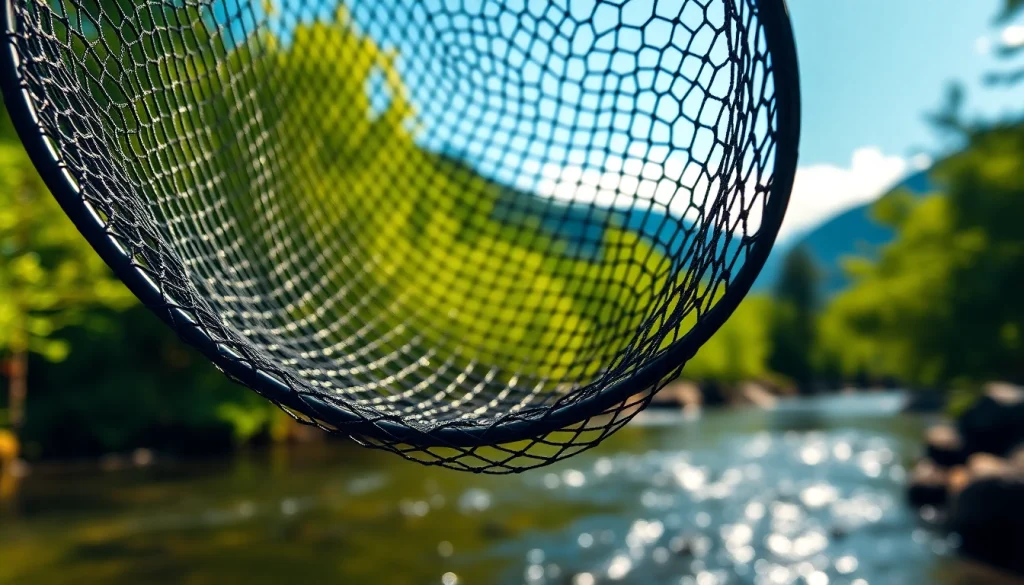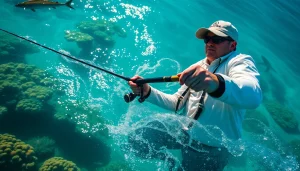Choosing the Right Fly Fishing Net for Your Next Adventure

The Importance of a Quality Fly Fishing Net
When it comes to fly fishing, the right equipment can make all the difference between a successful day on the water and a frustrating one. Among the various tools an angler carries, a quality Fly fishing net stands out as an essential item. While many might overlook this particular piece of gear, seasoned anglers understand its significance for both the fishing experience and the welfare of the fish being caught.
Why Every Angler Needs a Fly Fishing Net
Fly fishing is often regarded as a delicate art, requiring precision, technique, and, most importantly, an effective way to land fish. A fly fishing net serves several crucial roles: it allows anglers to land their catch more safely, minimizing harm to both the fish and the environment. Without a net, bringing a fish into hand manually increases the chances of injury, both to the fish and potentially to the angler.
Moreover, a quality net can enhance the overall fishing experience. It provides a way to catch and release fish with less stress, ensuring that the fish can swim away unharmed and continue thriving in its habitat. This is especially important for conservation efforts, as many species face pressure from overfishing and habitat loss. By using a net, anglers can contribute to sustainable fishing practices.
Key Features to Look for in a Fly Fishing Net
Not all fly fishing nets are created equal. Selecting the right one involves understanding the key features that contribute to performance and fish safety:
- Material: Lightweight frames made from aluminum or carbon fiber are preferred for their durability and ease of handling.
- Mesh Type: Rubberized or soft mesh materials help reduce damage to fish; these nets minimize the chances of injury or losing slime, which assists fish in staying healthy.
- Size and Shape: The design should accommodate the species targeted. Larger nets are more conducive to landing bigger fish, while smaller nets are ideal for trout and panfish.
- Handle Length: Depending on the fishing environment, a longer handle may be needed for landing fish in deeper waters, whereas a shorter handle may suffice for small streams.
- Foldability: Some nets offer a collapsible option, allowing for easy transport and storing, critical for anglers who need to pack light.
How a Good Fly Fishing Net Benefits Catch and Release
Catch and release has become a crucial practice among anglers to ensure the sustainability of fish populations. A quality fly fishing net is instrumental in this process. With the right net, rounding up a fish becomes smoother and faster, lessening the time the fish is out of the water.
Expert anglers emphasize the need to keep the fish in the water as much as possible while using the net to catch it. The quick maneuverability of a quality net can reduce the risk of stressing the fish. Features like a rubber mesh prevent the hooking of fish gills or fins, creating a less traumatic experience for the fish and increasing its chances of survival after release.
Types of Fly Fishing Nets Available
Different Materials Used in Fly Fishing Nets
When selecting a fly fishing net, the material can impact functionality, durability, and fish safety. Common materials include:
- Wood: Traditionally favored by many anglers for its aesthetic appeal, wooden nets can be heavy, making them less suitable for long excursions.
- Aluminum: Lightweight and rust-resistant, aluminum nets offer excellent durability. They are often used in a variety of fishing scenarios.
- Carbon Fiber: Even lighter than aluminum, carbon fiber nets provide exceptional strength. They can be ideal for serious anglers looking to minimize weight.
- Plastic: Economical and lightweight, plastic nets can be practical but may not offer the same longevity as other materials.
Comparing Sizes and Shapes of Fly Fishing Nets
Bigger does not always mean better when it comes to selecting the right fly fishing net. Here’s a breakdown of various shapes and sizes:
- Round Nets: Commonly used for smaller species, round nets feature uniform depth. They are great for catch-and-release situations.
- Rectangle Nets: These nets often provide better capacity for larger fish sizes and can offer broader capture areas.
- Sizes: Fly fishing nets usually range from 26 to 40 inches in hoop size. It’s essential to choose a size that aligns with the fish species targeted. Smaller nets are better for trout, while larger ones are needed for species like bass or pike.
Specialty Fly Fishing Nets for Unique Conditions
Terrain and environment heavily influence the choice of fly fishing nets. For unique conditions, consider these specialty nets:
- Wading Nets: These nets are typically smaller and more manageable, ideal for wading anglers who need to navigate rocky or fast-moving waters.
- Boat Nets: Larger and often equipped with longer handles, these nets provide better reach for landing fish from a seated position while in a boat.
- Surf Nets: Designed specifically for saltwater conditions, surf nets feature corrosion-resistant materials and longer handles to accommodate larger species.
How to Properly Use a Fly Fishing Net
Techniques for Efficiently Landing Fish
Using a fly fishing net effectively requires finesse. Here’s how to ensure you land fish successfully:
- Approach Calmly: As the fish nears exhaustion, maintain calm movements. Jerky motions may cause the fish to become agitated and make it harder to net.
- Positioning: Position the net beneath the fish while keeping it at a slight angle. This gives the fish less resistance and increases the chance to slide it into the net.
- Timing: Wait for the right moment. Once the fish is close, gently lift the net to cradle the fish from below instead of trying to scoop it from above.
Tips for Safe Catch and Release with a Fly Fishing Net
To ensure a successful catch and release, it’s crucial to minimize stress on the fish:
- Limit Air Exposure: Keep the fish in the water as much as possible to avoid stress and gill damage.
- Wet Your Hands: If you need to handle the fish, wet your hands to avoid removing the protective slime coating.
- Slow Recovery: Allow the fish to recover in the net while observing its behavior. When it’s ready, it will swim away naturally.
Best Practices for Handling Fish Using a Fly Fishing Net
Handling fish properly is vital for ensuring they thrive after being caught:
- Use the Net Correctly: Always support the fish’s body with the net, avoiding unnecessary strain on the jaw or fins.
- Avoid Long Struggles: While catching, try to land the fish as quickly as possible to lessen fatigue.
- Careful Release: Place the fish back in the water gently, holding its tail in the current until it swims away.
Maintaining Your Fly Fishing Net for Longevity
How to Clean Your Fly Fishing Net
Like any fishing gear, your fly fishing net requires regular maintenance. Here’s how to keep it in great shape:
- Rinse After Use: After each outing, rinse the net to remove dirt, debris, and salts that can lead to deterioration.
- Use Mild Soap: Occasionally, clean the net with mild soap and warm water to remove any buildup, taking care to avoid harsh chemicals that could damage the net material.
- Dry Thoroughly: Allow your net to dry completely before storing it to prevent mold and mildew.
Storage Tips for Your Fly Fishing Net
Proper storage enhances the lifespan of your fly fishing net:
- Use a Protective Case: If possible, store your net in a protective case or a designated area where it won’t be crushed or bent.
- Hang It Up: Hanging nets can help maintain their shape and prevent damage from other equipment.
- Avoid Extreme Temperatures: Try to keep your net in a moderate temperature environment, as extreme heat or cold can compromise the integrity of the materials.
Common Repairs for Damaged Fly Fishing Nets
Though sturdy, fly fishing nets can sustain occasional damage. Here’s how to handle common repairs:
- Reglue Wooden Frames: If your wooden frame nets come apart, using waterproof epoxy or wood glue can help reattach them securely.
- Patching Holes in Mesh: Small holes can often be mended with a patch or, for bigger problems, complete mesh replacements may be necessary.
- Replacing Handles: If a handle breaks, contact a local craftsman or look for compatible spare parts to replace.
Top Brands and Innovations in Fly Fishing Nets
Identifying Reliable Brands for Fly Fishing Nets
When shopping for a fly fishing net, brand reliability can impact performance. Look for brands known for durability, innovative designs, and positive customer reviews. Find models backed by warranties as assurance of their quality.
Innovative Features to Consider in Fly Fishing Nets
Technology continues to improve the functionality of fly fishing nets. Here are some innovative features:
- Telescoping Features: Nets that extend can make it easier to reach fish without straining.
- Interchangeable Nets: Some models allow for different mesh materials based on fishing environments.
- Built-in scales: Some nets even come with integrated scales to quickly check fish weight and compliance with regulations.
Community Recommendations for Best Fly Fishing Nets
Engaging with the fishing community for recommendations can provide invaluable insights. Online forums, local fishing clubs, and social media groups often share experiences and advice on the best fly fishing nets. Learning from fellow anglers allows you to discover nets that work well in your area’s specific fishing conditions and species.







